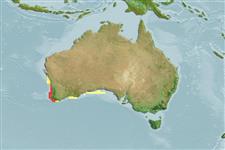>
Syngnathiformes (Pipefishes and seahorses) >
Syngnathidae (Pipefishes and seahorses) > Syngnathinae
Etymology: Phyllopteryx: Greek, phyhllon = leaf + Greek, pteryx = wing, fin (Ref. 45335); dewysea: Named for Mary ‘Dewy’ Lowe, for her love of the sea and her support of seadragon conservation and research.
Eponymy: Mary ‘Dewy’ Lowe was honoured “for her love of the sea and her support of seadragon conservation and research”. She is the co-founder of the Lowe Family Foundation. The binomial apparently combines her nickname with the English word ‘sea’. (Ref. 128868), visit book page.
Environment: milieu / climate zone / depth range / distribution range
Ecologia
marinhas associadas(os) a recifes; intervalo de profundidade 50 - 72 m (Ref. 100032). Tropical
Distribuição
Países | Áreas da FAO | Ecossistemas | Ocorrências | Point map | Introduções | Faunafri
Eastern Indian Ocean: Western Australia.
Tamanho / Peso / Idade
Maturity: Lm ? range ? - ? cm
Max length : 25.9 cm TL macho/indeterminado; (Ref. 100032)
Descrição suscinta
Chaves de identificação | Morfologia | Morfometria
This species is distinguished by its red colour, and pink vertical bars that extend halfway up the body to the lateral trunk ridges; it has 18 trunk segments; head crest without appendage; enlarged pectoral area; dorsally enlarged spine on trunk ring 11 that is pointed forward; a pair of enlarged ventral spines on rings 8 and 17; the body deepest on ring 12, behind dorsal spine; spines on lateral trunk ridge are not continuous with lateral tail ridges (Ref. 100032).
Occurs more offshore in slightly deeper waters; at 50+m with complex habitat of a mixed reef and sandy habitat with two paratypes collected from the continental shelf (Ref. 100032).
Ciclo de vida ou comportamento de acasalamento
Maturidade | Reprodução | Desova | Ovos | Fecundidade | Larvas
Stiller, J., N.G. Wilson and G.W. Rouse, 2015. A spectacular new species of seadragon (Syngnathidae). R. Soc. Open Sci. 2(140458.):1-12. (Ref. 100032)
Status na Lista Vermelha da UICN (Ref. 130435: Version 2024-2)
Ameaça para os humanos
Harmless
Uso pelos humanos
Pescarias:
Ferramentas
Relatórios especiais
Baixar XML
Fontes da internet
Estimates based on models
Índice de diversidade filogenética (Ref.
82804): PD
50 = 0.7500 [Uniqueness, from 0.5 = low to 2.0 = high].
Bayesian length-weight: a=0.00447 (0.00175 - 0.01142), b=2.99 (2.77 - 3.21), in cm total length, based on LWR estimates for this (Sub)family-body shape (Ref.
93245).
Nível Trófico (Ref.
69278): 3.4 ±0.5 se; based on size and trophs of closest relatives
Resiliência (Ref.
120179): Elevada, tempo mínimo de duplicação da população menor que 15 meses (Preliminary K or Fecundity.).
Fishing Vulnerability (Ref.
59153): Low vulnerability (16 of 100).
